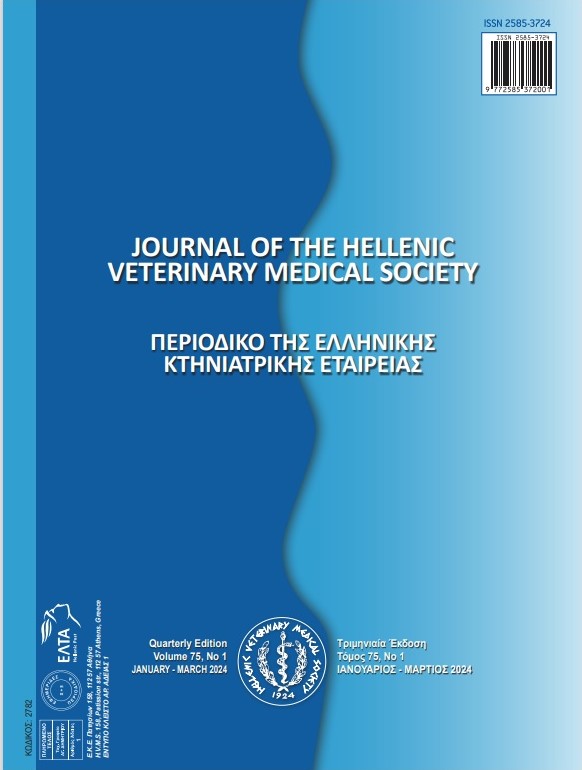the Effect of propolis supplementation on productive performance and immunity response of suckling Friesian calves

Abstract
Objective of this study was to investigate the effect of propolis supplementation on productive performance and blood profile of suckling Friesian calves.
Eighteen newly born male Friesian calves with average live body weight of 26.11±0.53 kg are assigned into three similar groups after colostrum. Calves were unsupplemented in G1 and served as control, or supplemented with at the levels of 0.5 and 1.0 g propolis/head/day in G2 and G3, respectively. The best values of all nutrients digestibility and feeding values were recorded to G3 followed by G2, whereas G1 had the poorest values. Ruminal TVFA’s, acetate and propionate concentrations and serum total protein, globulin, albumin and glucose concentrations were significantly higher (P<0.05), however, ruminal pH value and ammonia-N and butyrate concentrations and serum urea-N, creatinine, AST and ALT concentrations were significantly lower (P<0.05) in G3 followed by G2 and vise versa in G1. Also, G3 had the highest immunoglobulins (IgG, IgA and IgM), haemoglobin concentration (HGB) and Haematocrit (a packed-cell volume) percentage (PCV), counts of leucocytes (WBC’s) and their differential (lymphocytes, monocytes, neutrophil, eosinophil and basophil), erythrocyte (RBC’s) and erythrocyte indices including mean cellular volume (MCV), mean cellular haemoglobin (MCH), mean cellular haemoglobin concentration (MCHC) and red cell distribution width (RDW) and platelet indices expressed as platelet count (PLT), procalcitonin (PCT), mean platelet volume (MPV) and Platelet Distribution Width (PDW) concentrations followed by G2, while G1 had the lowest concentrations (P<0.05). Weaning weight, total weight gain and average daily gain were significantly higher (P<0.05) in G3 followed by G2, while the lower values were in control ones (G1). Intakes of TDN and DCP were significantly higher (P<0.05) in G3 compared to G1 with insignificant differences with G2. Feed conversion ratio was significantly (P<0.05) better with G3 compared G1, while G2 differ significantly in DM and CP/kg gain and insignificantly in TDN and DCP/kg gain with both G1 and G3. Feed cost was higher significantly (P<0.05), but feed cost of gain was lower significantly (P<0.05) in G3 compared to G1, and insignificantly with G2. While, G3 recorded significantly (P<0.05) the highest revenue of weight gain, net revenue, relative net revenue and economic efficiency followed by G2, but G1 had the lowest values.
In conclusion, propolis supplements at the level of 1 g/calf/day for suckling calves led to significant improvements on productive performance and blood profile.
Article Details
- How to Cite
-
Gaafar, H., Mesbah, R., Shams, A., & El-Nahrawy, M. (2025). the Effect of propolis supplementation on productive performance and immunity response of suckling Friesian calves. Journal of the Hellenic Veterinary Medical Society, 75(4), 8203–8216. https://doi.org/10.12681/jhvms.35383
- Issue
- Vol. 75 No. 4 (2024)
- Section
- Research Articles

This work is licensed under a Creative Commons Attribution-NonCommercial 4.0 International License.
Authors who publish with this journal agree to the following terms:
· Authors retain copyright and grant the journal right of first publication with the work simultaneously licensed under a Creative Commons Attribution Non-Commercial License that allows others to share the work with an acknowledgement of the work's authorship and initial publication in this journal.
· Authors are able to enter into separate, additional contractual arrangements for the non-exclusive distribution of the journal's published version of the work (e.g. post it to an institutional repository or publish it in a book), with an acknowledgement of its initial publication in this journal.
· Authors are permitted and encouraged to post their work online (preferably in institutional repositories or on their website) prior to and during the submission process, as it can lead to productive exchanges, as well as earlier and greater citation of published work.



